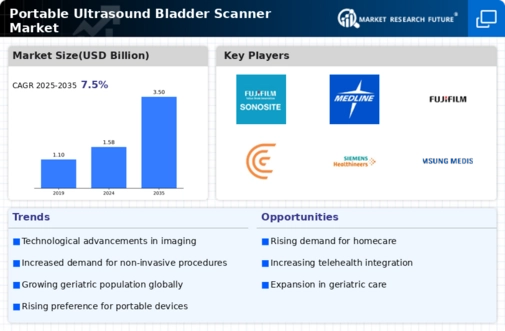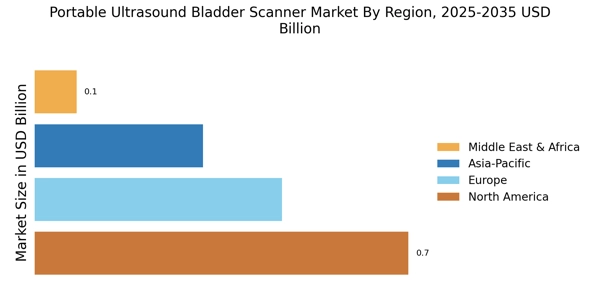Growing Awareness of Bladder Health
The Portable Ultrasound Bladder Scanner Market is benefiting from a growing awareness of bladder health among both healthcare professionals and patients. Educational initiatives and campaigns aimed at promoting bladder health are becoming more prevalent, leading to increased screening and early detection of bladder-related issues. This heightened awareness is likely to drive demand for portable ultrasound bladder scanners, as they provide a quick and effective means of assessment. Market Research Future indicates that the awareness campaigns have contributed to a 15% increase in the adoption of these devices in clinical settings. As more individuals recognize the importance of bladder health, the Portable Ultrasound Bladder Scanner Market is poised for continued growth.
Rising Incidence of Urinary Disorders
The Portable Ultrasound Bladder Scanner Market is significantly influenced by the rising incidence of urinary disorders, including urinary incontinence and bladder retention. These conditions are becoming increasingly common, particularly among the elderly population. The need for effective diagnostic tools to manage these disorders is driving the demand for portable ultrasound bladder scanners. According to recent statistics, urinary disorders affect approximately 30% of older adults, creating a substantial market opportunity for these devices. Healthcare providers are increasingly adopting portable scanners to facilitate timely diagnosis and treatment, thereby enhancing patient care. This trend suggests a robust growth trajectory for the Portable Ultrasound Bladder Scanner Market in the coming years.
Technological Advancements in Imaging
The Portable Ultrasound Bladder Scanner Market is experiencing a surge in technological advancements that enhance imaging capabilities. Innovations such as 3D imaging and real-time visualization are becoming increasingly prevalent. These advancements not only improve diagnostic accuracy but also facilitate quicker assessments, which is crucial in clinical settings. The integration of artificial intelligence in these devices is also noteworthy, as it aids in automating measurements and reducing human error. As a result, healthcare providers are more inclined to adopt these advanced scanners, leading to a projected growth rate of approximately 8% annually in the Portable Ultrasound Bladder Scanner Market. This trend indicates a shift towards more sophisticated diagnostic tools that can be utilized in various healthcare environments.
Cost-Effectiveness of Portable Solutions
The Portable Ultrasound Bladder Scanner Market is also experiencing growth due to the cost-effectiveness of portable solutions. These devices offer a more affordable alternative to traditional imaging methods, which often require extensive infrastructure and resources. The ability to perform bladder assessments at the point of care reduces the need for expensive hospital visits and lengthy procedures. Market analysis indicates that the cost savings associated with portable ultrasound bladder scanners can be substantial, potentially reducing overall healthcare expenditures by up to 20%. This financial advantage is appealing to healthcare providers and institutions, thereby driving the adoption of portable solutions in the Portable Ultrasound Bladder Scanner Market.
Increased Demand for Home Healthcare Solutions
The Portable Ultrasound Bladder Scanner Market is witnessing a notable increase in demand for home healthcare solutions. As the population ages and the prevalence of chronic conditions rises, patients are seeking more convenient and accessible healthcare options. Portable ultrasound bladder scanners offer a non-invasive and efficient means of monitoring bladder health from the comfort of home. This trend is further supported by the growing emphasis on patient-centered care, which prioritizes the needs and preferences of individuals. Market data suggests that the home healthcare segment is expected to account for a significant share of the Portable Ultrasound Bladder Scanner Market, potentially reaching 30% by 2026. This shift underscores the importance of portable devices in enhancing patient outcomes and satisfaction.


















Leave a Comment